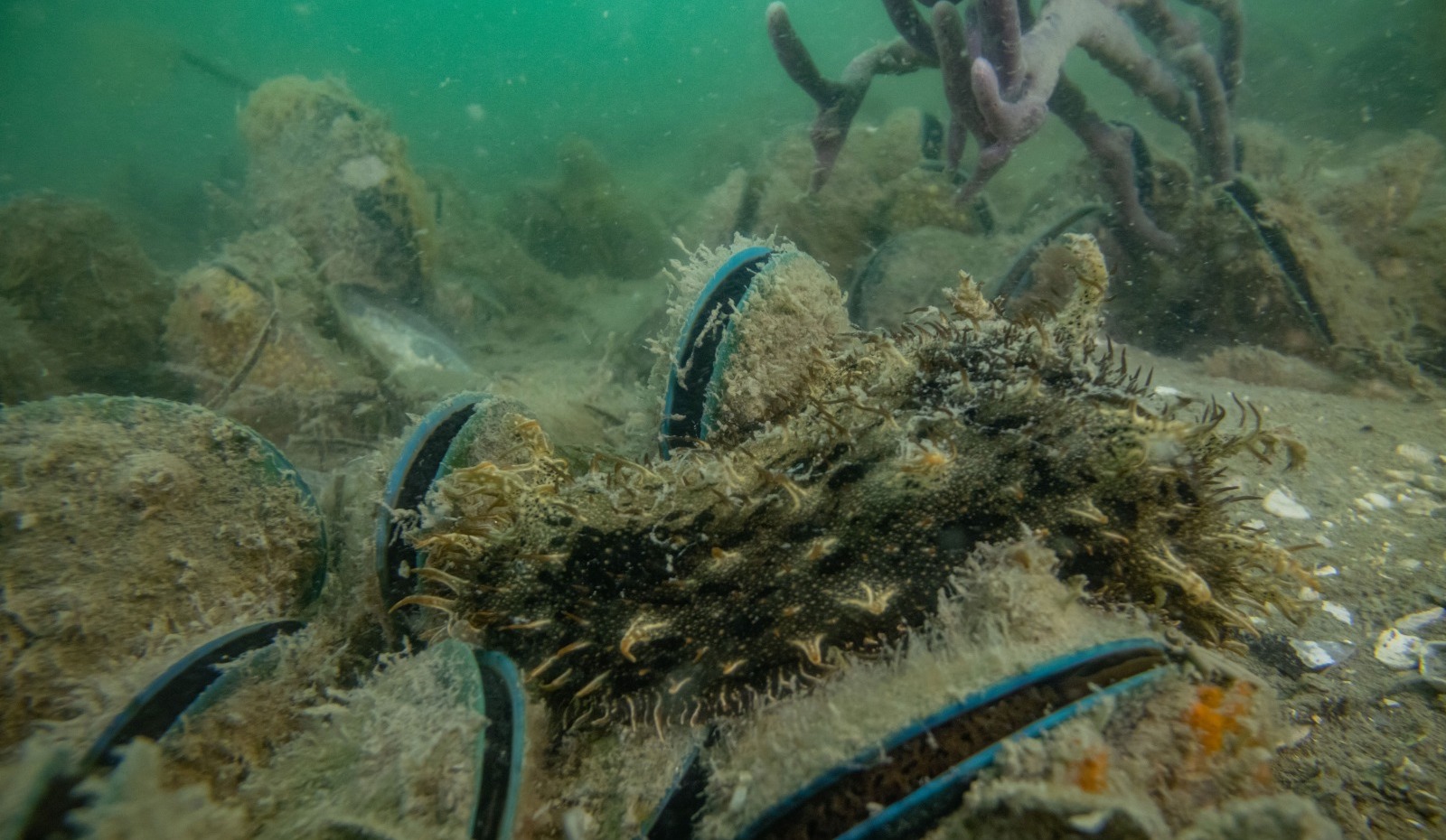Wai
Te mana o te WaiToitū te Waitematā
The urbanization of Tāmaki has come with an environmental cost. This is especially so for water, which generally been neglected, and often seen as a convenient means of waste disposal. Large parts of the City still have combined wastewater and stormwater networks, with deliberately engineered overflow points which discharge paru to our waterways, and ultimately the moana. For Ngāti Whātua Ōrākei this process reached its nadir in 1914 when the main sewer discharge line for Auckland was laid across the Ōkahu Bay foreshore – discharging directly onto our traditional kai harvesting areas.
We are working with Council and other agencies to address these legacy issues and retore the health of our waters. Recently we have worked with Watercare and the Council Healthy Waters team to achieve separation of the waste and storm water networks in Ōrākei. We are also working with Revive Our Gulf on a project to re-establish mussel beds in Ōkahu Bay.
In the longer term we have plans to “daylight” waterways which have been lost in pipes and culverts. Ultimately we aim to restore our ability to gather kai and swim safely as we did freely in the past. This work is guided by the Ōkahu Bay Environmental Restoration Plan.
This year we will also start work on a policy statement for Te Mana o te Wai.
Ōkahu Bay Restoration Project
We are proud to announce that Ngāti Whātua Ōrākei and the Revive Our Gulf project are working on a study that looks to build on past efforts to re-seed kūtai / mussel beds in Ōkahu Bay. This project forms part of a long-term, intergenerational environmental restoration kaupapa. This includes re-planting of the whenua and improving the health of the Waitematā. This is rooted in a need to re-establish kaitiakitanga and the physical and spiritual connection to the whenua, rohe and moana, after a sorry history of gradual land confiscation and desecration. Only two generations ago, Ōkahu Bay was the blue pantry or pātaka kai of the hapū, with plentiful shellfish and an ocean that was said to be ‘red with snapper’. By establishing kūtai beds in the Waitematā it is hoped that one day we can return to the traditional cultural practices of kohinga kai / food gathering from our moana. Again we acknowledge our whānau, partners and all those that have contributed to the wider kaupapa so far. We are excited to continue this mahi with the whānau so we can all be involved in helping our hapū and iwi protect and care for our wai – divers, fisherman, kaimoana lovers, paddlers, tātou katoa!
FAQ with Revive Our Gulf
-
No, please don’t! Even if you happen to be uri o Ngāti Whātua Ōrākei. You’ll wreck our experiment and chances are you’ll get really, really sick. Kūtai accumulated heavy metals, contaminants and bacteria in their flesh and Ōkahu Bay frequently is on the Safeswim high-risk list. Our hope is that our grandchildren’s grandchildren’s grandchildren will one-day have tasty, edible, safe kaimoana from the Waitematā.
-
Ōkahu Bay was once an important source of kai moana for Ngāti Whātua Ōrākei, with large shellfish beds of pipi and tuangi / cockles. Historical records from mussel dredging show that there were dense beds of green-lipped mussels in the Rangitoto channel and other places in the Waitematā. It’s not clear how close to the Ōkahu Bay shoreline these beds came, although we have found some large kūtai shells in and around the area we are working. All up, over 500 sq.km of kūtai reefs were dredge fished from the inner Hauraki Gulf between 1910 – 1965.
-
Generations upon generations of kūtai went into forming the reefs. Fishers in the day recall the kūtai coming up like ‘rolls of carpet’. Marine scientists believe this fundamentally damaged the habitat, removing structure critical to the settlement of kūtai larvae / spat like filamentous algae, hydroids and hard shell surfaces. Sedimentation adds to the challenge, where poor land use practices have resulted in the loss of filtering wetlands and deforestation allowing large volumes of sediment to flow into the Gulf, making the water more turbid and the seabed conditions more muddy.
Despite shellfish beds being one of the most threatened marine habitats on Earth, there is still a lot to learn about shellfish bed ecology. Our subtidal, soft-sediment kūtai (Perna canaliculus), a species unique to Aotearoa / New Zealand, present some specific challenges, with different habitat needs across its lifecycle when compared to well studied shellfish such as oysters.
-
Kūtai are quite hardy and can handle a moderate amount of sediment suspended in the water. However, they don’t like being buried in it. The shell hash base used in Ōkahu Bay (50m x 50m and approx. 30-50 cm high) will be used in a large-scale test to compare survival of kūtai placed on a shell vs soft sediment. We expect the shell to improve survival and encourage recruitment by lifting the kūtai out of the muck and providing an attachment substrate for juvenile mussels and other marine life.
-
A single adult kūtai can filter between 150–350 litres of seawater per day. Assuming each of our six plots has around 700,000 mussels that’s about 630+ million litres of filtration per day! It sounds big, but let’s not get too excited, it’s a drop in a bucket considering the volume of water in Ōkahu Bay (and tidal currents etc). However, we will be keeping an eye out for any localised improvements in turbidity across the beds. Biodiversity improvement should be more apparent and we expect to see more species, like crabs and shrimps, juvenile fish and starfish to show up around the beds within 6–12 months.

1 Year Update - Ōkahu Bay Restoration
Here are the highlights on how the reefs are doing.
After one year on the seafloor, the density of the mussel reefs was substantially lower than when they initially went in. This initial change is to be expected and was observed in the one-month survey and could be for a range of reasons including the mussels spreading out. However, there was little to no change in mussel densities from the previous (seven-month) surveys suggesting densities, and possibly mussel losses, have leveled out and are remaining consistent. Most mussels were generally oriented upright – in a vertical position.

Read More
-
The mussel size (growth) changed very little over the first year on the seafloor. Our team suggests that in general mussels have slower growth rates when they’re already adult in size, and also the environmental conditions at Ōkahu Bay are sub-optimal for mussel growth so we do not expect to see fast growth rates in the short-term.
Similar to the 7-month survey, we observed epibiota in the mussel reefs. Epibiota are organisms that live on other organisms – so in this case, we’re talking about the organisms that attach to mussels. The team observed small amounts of kelp, several sea stars, sponges, and encrusting ascidians (more commonly known as sea squirts) during their survey.
Two unwanted organisms, the Mediterranean fanworm, and the clubbed tunicate were observed in the reefs, but do not appear to be spreading extensively and are found elsewhere in the area off the mussel reefs as well.
For those following this project closely, you’ll know that half of the mussels were placed on a shell base, and the other half were placed directly onto the seafloor (mud). At this early stage, there’s little discernible difference in the results between the two sites.
Although this research is still in its infancy, these reefs provide a valuable test case for learning and knowledge building. We’ll collectively hold our breath over the summer with the forecast warm water temperatures and look forward to sharing further updates with you throughout 2023.

